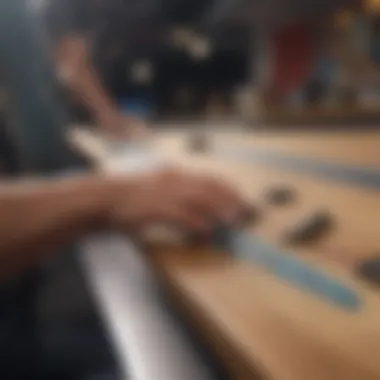Finger Board Shops: The Hub of Extreme Sports Culture


Intro
Finger boarding may seem like just child’s play to the casual observer, yet it has blossomed into a genuine passion for many enthusiasts around the globe. This miniature version of skateboarding, often performed on small wooden boards designed to mimic full-sized skateboards, has carved out a niche within the broader extreme sports culture. It's an intricate dance of skill, creativity, and community that has garnered attention from both participants and onlookers. The finger board shops, small yet impactful, serve as epicenters for this culture, where enthusiasts gather to exchange tips, browse unique gear, and engage in competitions.
This article aims to explore the vibrant universe of finger board shops, highlighting their importance in shaping the fingerboarding scene and providing resources and support to both rookies and seasoned pros. We'll delve into the gear that fuels this passion, the techniques that define mastery, the ethos of safety, events that elevate competition, and the community that binds it all together.
Through this comprehensive guide, we seek to broaden understanding and appreciation for fingerboarding—not just as a fleeting trend, but as a legitimate form of extreme sport that thrives thanks to dedicated shops and passionate communities.
Equipment and Gear
When it comes to finger boarding, the right equipment can make all the difference. Think of it like setting up a small skateboard for your fingers, where every component plays a vital role in a rider's performance and enjoyment. Key pieces of gear include the board, trucks, wheels, and grip tape.
Overview of Essential Gear
- Fingerboards: Typically, these are crafted from layered wood to replicate the feel of real skateboards. Brands like FlatFace and Tech Deck offer various shapes, sizes, and designs, catering to personal preferences.
- Trucks: This is the metal component that connects the board to the wheels. Options such as the 32mm and 34mm models from brands like Flying Gnar and Bustin' offer stability and control.
- Wheels: The size and hardness of wheels impact movement and control. Softer wheels provide better grip for tricks, while harder wheels allow for faster speeds.
Detailed Descriptions of Top Brands
Aside from popular brands like Tech Deck, other companies offer specialized products that enhance the overall fingerboarding experience. For instance, BlackRiver, known for its high-quality ramps, provides a plethora of finger board products. Customers appreciate their attention to detail, ensuring that not only are the boards performing well, but also looking great.
Tips on Maintenance, Upgrades, and New Advancements in Equipment
Keeping gear in tip-top shape should be a priority for any avid fingerboarder. A few maintenance tips include:
- Regularly clean the grip tape to ensure maximum traction.
- Check the tightness of the trucks; loose trucks might hinder performance during tricks.
- Upgrade wheels and trucks periodically to enhance your setup based on skill levels and preferences.
With technology evolving, brands continuously innovate their offerings. Look out for new materials and shapes designed to address not only performance but also aesthetic appeal.
"The right equipment can significantly elevate one’s performance, giving riders the confidence they need to push their limits."
This section sets the stage for the vital role finger board shops play in facilitating access to quality gear, aiding both novices and veterans alike on their fingerboarding journeys.
Understanding Finger Boarding
Navigating the world of finger boarding is akin to unlocking a hidden realm in the expansive universe of extreme sports. This section shines a light on the essence of finger boarding and its impact, setting the stage for the deeper exploration into finger board shops.
Definition and Origins
Finger boarding, at its core, is the practice of using miniature skateboards, controlled and maneuvered solely by fingers. Originating in the 1970s as a playful adaptation of traditional skateboarding, these small boards provided a way for enthusiasts to replicate tricks and techniques in a confined space. The first notable fingerboards were simple wooden contraptions, often crafted at home. As interest piqued, brands like Tech Deck began producing commercially available fingerboards, transforming the hobby into a legitimate subculture within skateboarding.
The allure of finger boarding can be attributed to its accessibility. Unlike standard skateboarding—where space and skill often create barriers—finger boarding can be enjoyed almost anywhere. Small enough to fit in a pocket yet rich in potential for tricks and creativity, these boards have nurtured a community that thrives on innovation. Furthermore, online platforms such as Facebook and Reddit have played a pivotal role in connecting finger board enthusiasts, fueling a growing network that shares tricks, tutorials, and events.
Cultural Significance in Extreme Sports
Finger boarding stands as a testament to how a subculture can carve its niche within the broad sphere of extreme sports. It may lack the adrenaline-pumping intensity of downhill skateboarding or the fierceness of BMX, but its cultural significance is no less profound. The camaraderie formed among finger boarders recalls the grassroots essence of skate culture—one grounded in community, creativity, and self-expression.
Many finger boarders participate in events that mimic larger skateboarding competitions. These events not only showcase individual skills but foster a sense of belonging among participants. Skill development becomes a collective pursuit, where seasoned players mentor newcomers, sharing techniques and fostering improvement.
"In the end, finger boarding is more than just finger gymnastics on wood; it's a gateway to community and creation, bridging people from diverse backgrounds through a shared passion."
As the sport evolves, so too does its infiltration into the realms of art and design. Custom setups, intricate designs, and unique accessories reflect the personal styles of boarders, turning simple fingerboards into canvases for self-expression. The cultural vitality of finger boarding ensures that it remains a rich part of the extreme sports narrative, continuously weaving new threads into the fabric of skate culture.
The Rise of Finger Board Shops
The emergence of finger board shops marks a significant chapter in the niche world of extreme sports. These shops have evolved from sporadic corner store offerings to specialized hubs that cater to a passionate community. For enthusiasts, having a dedicated space to explore finger boards enhances their experience and validates their passion. It's not just about purchasing a product; it's the holistic engagement with a community that encapsulates the adrenaline-fueled culture surrounding finger boarding.
Historical Context
Finger boarding first gained traction in the late 1990s, initially as a quirky offshoot of skateboarding. It started with simple wooden models that hobbyists crafted by hand. Over time, this grassroots scene began forming small collectives and communities, leading to the birth of shops dedicated solely to finger boarding.


"What started as a casual pastime ballooned into a dedicated culture of its own, creating spaces that foster connection among enthusiasts."
These shops evolved alongside the product offerings themselves, which have expanded into various brands and specialized equipment. The societal shift recognized finger boarding as not just a toy but a legitimate sport. Shops began hosting events and carving out roles in local communities, celebrating the sport's creativity and skill.
Market Growth and Trends
The finger boarding market has seen a noticeable uptick over the years, paralleling trends within broader extreme sports. Factors contributing to this growth include:
- Increased Accessibility: Finger boards are affordable and can be used almost anywhere, making them appealing to a wider audience.
- Merchandising Opportunities: Customization options have taken off, with enthusiasts eager to create one-of-a-kind setups.
- Influence of Social Media: Platforms like YouTube and Instagram have become playgrounds for finger board culture, showcasing performances and tutorials that spark interest among newcomers.
This growth isn’t merely quantitative; it’s qualitative, too. Shops are diversifying their product ranges, offering everything from complete boards to intricate accessories. The presence of specialized brands is on the rise, all vying for a spot in the burgeoning market. A surge in workshops and events has also emerged, providing skill development opportunities, thus solidifying the importance of finger board shops in cultivating new talent.
In summary, the rise of finger board shops reflects not just a commercial venture, but a cultural phenomenon. These shops provide essential support to a community that thrives on creativity, connection, and competition.
What to Expect from a Finger Board Shop
When you're diving into the finger boarding scene, knowing what to expect from a finger board shop can make all the difference in your journey. These hubs of creativity and community offer more than just products; they symbolize a culture. Finger board shops typically provide a vast array of items and services, all designed to cater to enthusiasts, newcomers, and collectors alike. Understanding their offerings can offer significant benefits in terms of skill development and community engagement.
Product Range and Offerings
Completes and Custom Builds
When it comes to finger boarding, one of the first things you will likely notice in a shop is the selection of completes and custom builds. Completes are ready-to-use finger boards that come fully assembled, ideal for newcomers who may not yet have the expertise to design their own setup. Often made with quality materials, these boards generally feature unique graphic designs that help express the user’s personality.
On the other hand, custom builds allow the true enthusiasts to harness their creativity. Individuals can mix and match different components, choosing specific decks, trucks, and wheels to create their unique board. This option is particularly popular for those seeking to cultivate a personalized riding experience that can even elevate their performance.
However, there’s a trade-off. Custom setups often require a deeper understanding of finger board mechanics, and can be pricier than completes. But many riders find the unique feature of being able to tailor their boards worth the extra investment.
Accessories and Add-ons
Accessories and add-ons play an important role in the fingerboarding experience, bringing extra flair and functionality. You’ll find everything from grip tape to ramps, tools, and storage. For instance, specialized grip tapes enhance control during tricks, while ramps enable enthusiasts to practice stunts in a controlled environment.
The accessory market is also constantly evolving, with many shops offering limited edition pieces that can serve as conversation starters among peers. However, a slight downside is that not all shops stock the same variety. Some may have a narrow focus on core items, missing out on trending accessories that other shops may capitalize on.
Brands and Varieties
Diversity in brands and varieties is another aspect that shines in finger board shops. Customers can expect to find a range of popular brands, each bringing something different to the table. Shops frequently carry products from well-known brands like Flatface and Blackriver, known for their high-quality components and innovative designs.
This variety allows consumers to make choices that fit both their personal style and budget. However, there's a caveat: with so many options comes the challenge of discerning quality. Not every brand stands the test of time, and some newer names may not deliver the same performance as established brands. It's always advisable to do a bit of research or ask around within the community to gauge the reliability of different brands.
Pricing Structures
Navigating pricing structures in finger board shops can feel like a balancing act. Generally, prices vary widely based on the components chosen. Ready-made completes set you back less, giving newcomers a lower barrier to entry. Custom parts, as mentioned earlier, can escalate quickly. Some quality brands are priced significantly higher, reflecting the craftsmanship and materials involved.
Additionally, it's essential to account for the fluctuating market trends. Some products may experience a spike in demand, which could affect their price. Seasonal sales and promotions can also provide opportunities for savvy shoppers to snag deals.
Keep an eye on shop websites or local events, often where promotions are announced, allowing you to save a few bucks while stacking up on your favorite gear.
Overall, understanding what to expect from finger board shops can help enthusiasts navigate their choices, ensuring they maximize both their financial investment and community involvement.
The Importance of Community
Community plays a pivotal role in the realm of finger boarding, especially within finger board shops. These small outlets aren't just about selling products; they are the heart and soul of urban recreational culture. The connections formed in these spaces foster relationships among enthusiasts of all ages, blending various skill levels and perspectives into a vibrant tapestry of experiences.
With fingers on the pulse of local happenings, these shops spur the growth of community ties, illuminate pathways for newcomers, and inspire a sense of belonging. Encouraging social interaction, they bridge gaps, turning strangers into friends, and create networks that transcend the boundaries of mere sport.
Local Events and Competitions
Community Engagement


One notable aspect of community engagement in finger boarding is the way it turns competition into collaboration. Instead of being just a showdown of prowess, local events are occasions where participants can learn from one another while showcasing their skills. This 'learning through sharing' creates an environment where everyone feels welcomed, and the stakes feel lighter. Shops often sponsor such events, effectively intertwining their identity with the growth of the sport.
A key characteristic of community engagement is its relaint on personal interaction. Face-to-face connections build trust and camaraderie, allowing members to share tips, exchange techniques, or even lend gear. Further fueled by social media, these interactions often extend beyond events, as players engage in discussions about tricks or modifications online.
The unique feature of community engagement here lies in its inclusivity. Whether an expert fingerboarder or someone just dipping their toes into the sport, the environment crafted by these shops is often noted for being non-threatening and friendly. This welcoming vibe can significantly draw in new participants, though it can occasionally challenge purists who prefer a more serious competition.
Skill Development Opportunities
Skill development opportunities within these shops often manifest not just in formal lessons, but through informal mentorship. Local pros may share their knowledge with younger players, taking the time to help them improve their techniques. This organic collaboration can create a ripple effect, enhancing the quality of play across the community.
A key characteristic of skill development here is its grassroots nature. Unlike more formal coaching setups, mentorship allows for personalized feedback, helping players evolve in ways that suit their unique styles. Events like clinics often hosted by shops enable enthusiasts to gain insights from seasoned boarders while mingling with fellow learners.
The unique feature in these scenarios is the level of accessibility they provide. Most gatherings are open to anyone, regardless of their skill levels, making it a beneficial platform for all. This openness helps stitch deeper ties within the community, though it can sometimes lead to a disparity in skill representation during events.
Online Communities and Networking
The rise of online platforms has given finger boarding a new dimension. Social media networks, forums like Reddit, and dedicated Facebook groups have become vital spaces where players share tips, showcase tricks, and even buy or swap equipment. This digital landscape allows for wider networking opportunities that traditional shops can't always offer.
The accessibility of online communities enables enthusiasts from various regions to connect and collaborate without geographical constraints. Whether someone posts a trick tutorial or a live-streaming session of their latest attempt, the potential for interaction seems boundless. However, it can lead to overcrowding, where quality discussions may get drowned out by random chatter.
Now the challenge is creating a balanced environment that encourages participation without sacrificing quality. Through both local shops and online forums, finger boarders can cultivate a collective spirit, keeping the sport vibrant and engaging for all.
The Role of Finger Board Shops in Education and Training
Finger board shops do more than just sell mini skateboards; they act as pivotal hubs for fostering education and training within the fingerboarding community. Their influence spans from introducing novices to the sport to sharpening the skills of seasoned enthusiasts. This section delves into how these shops contribute significantly to the learning landscape of fingerboarding, emphasizing specific techniques and educational opportunities they provide.
Teaching Techniques and Styles
The teaching methods employed in finger board shops can vary dramatically. By adopting a hands-on approach, these shops create an environment where students can learn through direct experience. This method often resonates well with younger audiences, making the learning process engaging and enjoyable.
- Demonstration-Based Learning: Instructors often showcase tricks and maneuvers, allowing learners to visually absorb techniques before hitting the board themselves.
- Peer Learning: More experienced riders share insights with novices, fostering a collaborative spirit. This not only builds camaraderie but also allows for a practical exchange of knowledge.
- Goal-Oriented Sessions: Classes may focus on specific skills, such as flips or grinds. This targeted approach can help learners see progressive improvement and maintain motivation.
It's not uncommon for passionate instructors to adapt their teaching styles based on the crowd. They might blend different techniques, ensuring that every participant, regardless of skill level, finds a pathway to improvement.
"In fingerboarding, as in life, practice makes perfect. No one becomes a pro overnight—but the right guidance makes the journey smoother."
Workshops and Clinics
Workshops and clinics organized by finger board shops serve as structured learning opportunities that can significantly enhance skill development. These events not only provide focused training but also stimulate community engagement. Here are some key aspects:
- Regular Workshops: Many shops host weekly or monthly workshops, covering a range of topics from basic tricks to advanced techniques. These regular sessions help create a sense of continuity for learners.
- Special Guest Events: Sometimes, seasoned fingerboarders are invited to lead clinics, offering rare opportunities to learn from the best directly.
- Skill-Level Tailoring: Shops often provide workshops tailored to varying skills. Separate sessions for beginners and advanced riders ensure personalized attention and relevant instruction.
- Community Spirit: Beyond just the technical skills, workshops foster bonding experiences among participants. Many riders form lasting friendships, further encouraging group practice and skill sharing outside of the shop walls.
In summary, the role of finger board shops in education and training is invaluable. They create a supportive learning environment through innovative teaching techniques and organized workshops. By doing so, they elevate the fingerboarding experience, fostering a community of knowledgeable and skilled riders.
Building Your Own Finger Board Shop
Starting a finger board shop can be a fantastic venture, especially in a niche market that continues to draw in new enthusiasts. The significance of this topic lies in the dual benefits it offers: the chance to cultivate a community around a unique passion and the opportunity for financial gain. The right approach to planning and execution can make your shop not only a place for selling but also a hub for creativity and engagement among finger boarding aficionados.
Market Research and Planning
Before you dive headfirst into the world of finger board shops, it’s essential to grasp the dynamics of the market. Just like in any business, understanding your audience is paramount. Start by gathering information on who your potential customers are. Are they long-time collectors? Newcomers eager to try their hand at tricks? Knowing their preferences will inform your inventory choice.
- Identify Your Niche: Decide whether you want to cater to casual buyers or serious competitors. Each subgroup often has differing needs.
- Check Out Competitors: Look at existing shops, both local and online. Analyzing their offerings, pricing, and customer engagement strategies provides insight into what works and what could be improved.
- Connect with the Community: Engage with enthusiasts through forums like reddit.com, social media platforms such as facebook.com, or local events. Their feedback can be gold for refining your concept.
Draft a solid business plan that outlines your vision, target market, marketing strategies, and finances. This plan can serve as the backbone for your shop and will come in handy if you decide to seek funding or collaboration.
Legal Considerations and Regulations
Once the planning mind-set is in place, the next step is to consider the legal framework of running a shop. While the thrill of setting up a finger board shop can be intoxicating, neglecting legalities can surely rain on your parade.
- Business Structure: Determine what kind of business entity suits you. Sole proprietorship, LLC, or maybe a partnership might be options depending on how you want to run things. Each has its implications for taxes and liability.
- Permits and Licenses: Depending on your local laws, you might need specific permits to retail goods. Research your local regulations and get those ducks in a row.
- Taxes: Be mindful of sales tax and how it applies to the items you sell. Setting up an accounting system to track expenses, sales, and tax liabilities from the get-go can save a massive headache down the line.
"Starting a business is a lot like finger boarding; it takes practice, balance, and a good understanding of how to land your tricks smoothly."
Navigating these legal considerations may seem daunting, but they lay the groundwork for ensuring your shop can thrive without unwanted hiccups. Knowing what paperwork you need will keep you focused on what truly matters: building a vibrant community of finger boarding lovers.
Challenges Facing Finger Board Shops
In the midst of a growing fingerboarding culture, finger board shops face a unique set of challenges that could impact their success and sustainability. Understanding these challenges is crucial as they shape the very basis of the community and market surrounding fingerboarding. As enthusiasts continue to rise in number, so do the obstacles that shops must navigate to both survive and thrive.


Competition from Online Retailers
One of the most significant challenges finger board shops encounter is the competition from online retailers. The digital shopping experience offers convenience that local shops sometimes struggle to match. Customers can easily browse vast selections and often find lower prices with just a few clicks. This accessibility completely changes the landscape for fingerboard shops, pushing them to find innovative ways to engage with their customer base directly.
Hoy often, shops are caught in a bind. They might stock high-quality or unique items but find themselves overshadowed by the sheer volume of product and quick shipping options available on platforms like Amazon or specialized online fingerboarding sites. Yet, local shops have strengths that online giants may not replicate.
- Personalized Service: One clear advantage is personal interaction. Local shops can build relationships with customers, offering tailored advice and insights on products. Monthly contests or local skateboarding events could further cement this bond, making in-person purchases a more appealing option than ordering from home.
- Niche Community Hub: Shops can host workshops, training sessions, and events that foster community and skill development. These local gatherings make in-store visits more than just shopping—they become experiences.
- Exclusive Products: Many shops can sneak a peek behind the curtain to collaborate with artisans and create limited-edition runs of products that online retailers cannot offer. Customers are likely to flock to stores where they might find something one-of-a-kind.
"Local shops may need to pivot their strategies, focusing on what's unique about them and what they can offer that online competitors can't."
Sustaining Local Interest and Engagement
Building a lasting, engaged customer base is another hurdle finger board shops must overcome. Sustaining local interest can prove tricky in a rapidly changing digital age when lures of instant gratification available online are ever-present. If local finger board shops want to stay relevant, they need to stay proactive in creating a sense of community around their offerings.
Elements of community engagement can include:
- Loyalty Programs: Implementing loyalty programs with discounts for frequent buyers can incentivize repeat visits, encouraging customers to return rather than seeking cheaper options online.
- Social Media Presence: Actively engaging with customers online—posting competitions, featuring customers’ tricks, or making fun challenges—can create buzz and draw local talent into the store.
- Inclusive Events: Hosting events that cater to all skill levels brings different segments of the community together. It's not just about the exceptional fingerboarder—it’s about everyone who enjoys the community.
Balancing these efforts requires ingenuity, yet the payoff can be significant. When customers feel connected on a personal level, they are more inclined to support the shop, choosing it over the allure of online convenience.
Adapting to current market trends and understanding customer needs is essential. The future of finger board shops rests largely on their ability to counter online competition and nurture authentic community involvement.
Future Trends in Finger Boarding
The world of finger boarding is evolving faster than a skater on a half-pipe. Understanding the future trends in finger boarding is essential, as it offers insights not only into what we can expect in terms of products and technology but also hints at the growing community's preferences and habits. As finger boarding continues to carve its niche within the extreme sports scene, engaging with these trends will be beneficial for shops, manufacturers, and enthusiasts alike.
Innovations in Product Design
When it comes to innovations in product design, creativity knows no bounds. Finger boards have come a long way from the generic wooden planks of the past. Today, we see an exciting mixture of materials like carbon fiber, plastic composites, and even bamboo being utilized. These materials aren't just for show—they provide enhanced durability and performance.
Consider the rise of customizable finger boards. Many shops offer kits allowing users to design their own boards to fit personal styles. From unique graphics to personalized shapes and sizes, these innovations cater to enthusiasts' desires for individuality. Not to mention, the trend towards eco-friendly materials is gaining traction. As sustainability becomes a priority, brands are beginning to adopt more environmentally responsible practices.
"The evolution of finger board design doesn't just change aesthetics; it fundamentally alters how tricks can be performed."
Additionally, the shape of finger boards is also evolving. The introduction of concave designs makes it easier for users to perform various tricks. Shoppers can now choose from boards with varying degrees of concavity, allowing for a personalized riding experience tailored to skill levels. As technology continues to improve, 3D printing also offers a new avenue for product innovation, granting the ability to create intricate designs and unique shapes that were once too costly to manufacture.
The Impact of Technology on Finger Boarding
Technology isn’t just reshaping how finger boards are made; it’s also redefining how enthusiasts connect and learn. Most fingerboard enthusiasts are active on platforms like Reddit and Facebook, where they can share tips, tricks, and even video tutorials. This interactivity fosters a sense of belonging and encourages newbies to dive into finger boarding with confidence.
Moreover, the rise of mobile applications and virtual reality experiences is starting to filter into the fingerboarding realm. Imagine using a VR headset to practice finger boarding without the need for a physical board! Such advancements make it possible to hone skills and learn new tricks in a controlled environment. This can offer a safe space for beginners to experiment without the risk of physical injury.
On the side of retail and shop management, technology has also played a significant role. Shops are leveraging social media marketing and e-commerce platforms to reach a wider audience. Inventory management systems have transformed the way shop owners understand their stock and customer preferences, allowing them to rapidly adjust their offerings based on real-time data.
In summation, keeping an eye on the future trends in finger boarding reveals a landscape filled with promise. From product innovations that enhance performance to technological advancements fostering community engagement, the future looks bright for finger board enthusiasts. Both shops and individuals should prepare to adapt to these changes, ensuring they stay relevant in this dynamic and exciting world.
Ending
Understanding the dynamics of finger board shops offers valuable insights into the niche yet vibrant world of fingerboarding. This article highlights several key elements that solidify the importance of these shops, particularly in how they contribute to the culture, education, and sustainability of the sport.
Recap of Key Points
The journey through this exploration touches on numerous aspects:
- Origins and Definition: Recognizing fingerboarding's roots in skateboarding, we see how it evolved into a distinctive trend.
- Community Significance: Finger board shops are much more than retail spaces; they serve as hubs for enthusiasts, fostering collaboration and competition through local events and workshops.
- Product Offerings: From completes to custom builds, these shops provide an extensive array of products that cater to both new and seasoned fingerboarders.
- Challenges and Trends: As technology progresses, fingerboard shops face challenges from online platforms, yet they adapt by innovating and creating engaging in-store experiences.
In reviewing these points, it becomes clear that finger board shops hold a significant place in nurturing interest and passion in fingerboarding. They contribute not only to individual skill development but also strengthen the community ties that make this sport so enriching.
The Enduring Legacy of Finger Boards
The legacy of finger boards runs deeper than mere tricks and stunts. They represent a form of artistic expression, skill, and community.
- Creativity in Motion: Every maneuver, whether a kickflip or a grind, embodies years of practice and innovation. Finger boarding allows participants to translate their skateboarding dreams into miniature form, where creativity knows no bounds.
- Cultural Impact: Through the years, fingerboards have significantly impacted youth culture, contributing to a mindset that embraces self-expression and resilience. From street corners to backyards, the spirit of fingerboarding can be felt among participants of all ages.
- Future Generations: As new technologies and designs emerge, the legacy continues to evolve. The fingerboarding community meets change head-on, integrating new tools while holding true to its roots within extreme sports culture.
In summary, finger board shops serve as catalysts not just for sales, but as integral players in preserving and expanding the heritage of fingerboarding. Those who engage with these shops become part of a larger story, ensuring that the passion for fingerboarding will ripple through future generations.















